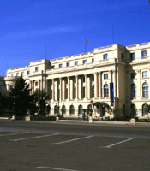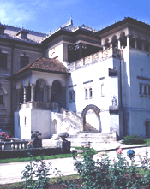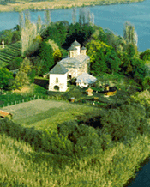|
|
BUCHAREST ATTRACTIONS
Once known as the "Little Paris”, Bucharest, Romania’s capital, is known
for its wide, tree-lined boulevards, and glorious Belle Époque
buildings. There is even an Arc de Triomphe on a boulevard longer than
the Champs Elysees, with a range of trees that flower beautifully in the
spring. You will be intrigued by the city's eclectic mixture of
architecture, from old monasteries to Orthodox Churches, Second Empire
mansions, the solid Stalinist architecture of the communist years and
the colossal Parliament House, the second largest building in the world
after the Pentagon.
Most popular Bucharest attractions
 The Parliament Palace (Palatul Parlamentului) Bucharest The Parliament Palace (Palatul Parlamentului) Bucharest |
Beginning in 1972, Ceauşescu instituted a program of systematization. Promoted as a way to build a "multilaterally developed socialist society," the program of demolition, resettlement, and construction began in the countryside, but culminated with an attempt to completely remodel the country's capital. Over one fifth of central Bucharest, including churches and historic buildings, was demolished during Ceauşescu's rule in the 1980s, to rebuild the city in a socialist style. Many people died during the erection of The People's House ("Casa Poporului") in Bucharest, now the Parliament House, the world's second largest building after The Pentagon. |
 |
 National Art Museum (former Royal Palace) Bucharest National Art Museum (former Royal Palace) Bucharest |
Romania's leading art museum was founded in 1948 to house the former Royal Collection along with those of various other museums in the country's capital.
The aim of the museum is to provide a comprehensive view on Romanian art from the early Middle Ages to the present, in as broad an European context as possible.
|
 |
 Romanian Atheneum (Ateneul Roman) Bucharest Romanian Atheneum (Ateneul Roman) Bucharest |
Founded in 1868, at the initiative of a group of musicians, in order to cultivate the taste of the public for symphonic music, the Romanian Philharmonic Society offered classical and romantic masterpiece concerts.A traveller who knows Bucharest only from the classic tourist brochures surely has one image engraved in his mind: the Romanian Atheneum, a symbol of the city as far back as its 1888 inauguration.
|
 |
 The Village Museum (Muzeul Satului) Bucharest The Village Museum (Muzeul Satului) Bucharest |
The Village Museum, lying in a specific romanian setting, on the Herăstrău lake shore in Bucharest, is one of the biggest and the oldest outdoors museum in Europe. Its exibits - genuinemonuments including houses, pens, churches, water and wind mills, cloth mills, of great historic and artistic value - acquaint the visitors in two hours with the specific of the Romanian village.
|
 |
 The Cotroceni Palace Bucharest The Cotroceni Palace Bucharest |
part of the Cotroceni National Museum which is a specialized institution focused upon reflecting the history of the Medieval and Modern Cotroceni, upon the evolution and transformations that came up in time. The Cotroceni palace, church and monastery reflect a three-century history that interweaves political, military, diplomatic, religious and cultural aspects, directly with the general evolution of Romanian society. |
 |
 Snagov Monastery Bucharest Snagov Monastery Bucharest |
The monastic establishment is located on a small island of Snagov Lake. It was first founded in the fourteenth century by Mircea cel Batran Voivode, and then it was refoundedby Vladislav II Voivode and Vlad Tepes Voivode in the fifteenth century. The present-day Church building was constructed during the reign of Neagoe
Basarab within the years1517 and 1521.
Monastery said to be the final resting place of Vlad
(Count) Tepes, also known as Vlad Dracula. |
 |
|



